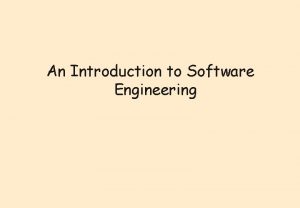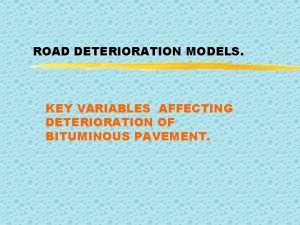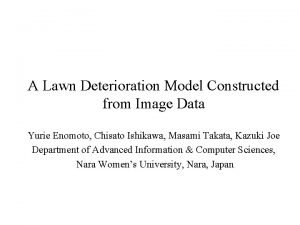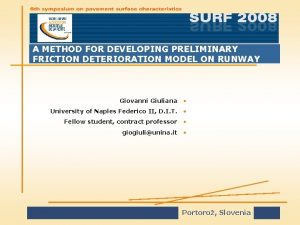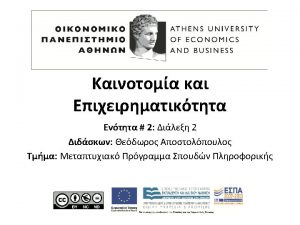Deterioration models Importance of deterioration model For any
















- Slides: 16

Deterioration models

Importance of deterioration model � For any asset ◦ A deterioration model can be constructed , ◦ Predictions can be made regarding asset conditions without the need to carry out the CA survey, which is, �Time consuming and �Very expensive if done at microscopic level � Main issues with the construction of deterioration model ◦ ◦ Time consuming process Requires lots of data Trial and error A lot of testing and validation need to be carried out

Deterioration models � So far only two fields of study has comprehensive deterioration models; ◦ Bridge and ◦ Pavement � Model construction ◦ Complex mathematical models �Markov chains �Bayesian models, amongst others.

AM stages Inventory Update database Asset worth Decision making Asset conditions Asset deterioration

Prioritization of assets � Tabulating � Option assets in order of defined criticality 1 ◦ Most defective asset ranked first and the rest follows with the last asset being the one requiring less attention � Option 2 ◦ Less defective asset ranked first and the rest follows with the last asset being the one requiring more attention

Prioritization of assets Printer ID Remaining Service Life Cost to Maintain/repair /rehabilitate PC 0012 2 2, 100 PC 1120 3 3, 090 PC 0022 3 2, 100 PC 1102 1 1, 500 PC 2220 0 0 PC 0007 3 1, 500 PC 0029 0 0 Rank after Prioritization

Benefit Cost Analysis (BCA)

Introduction � BCA - systematic evaluation of the economic advantages (benefits) and disadvantages (costs) of a set of investment alternatives. � Base case is mandatory � Alternatives – betterment options � Alternatives are compared to base case. � A benefit-cost analysis tries to answer the question: ◦ What additional benefits will result if this Alternative is undertaken, and what additional costs are needed to bring it about?

BCA � In the past, Asset managers were using engineering concepts solely for decision making with respect to which asset need to be repaired/rehabilitated or renew first. � Now apart from engineering concepts, they are also using economic theories – when they try to justify their investments – rate of return for every money spent.

BCA example - Highway system � Our agency, in this example, is managing highways. � What kind of benefits will be produced by improving highways? What are the Costs required to bring about the betterment/improvement.

BCA example - Highway system � Benefits ◦ Travel time savings ◦ VOC ◦ Safety benefits � Costs ◦ The value of the resources that must be consumed to bring the project about. ◦ Capital costs ◦ Major rehabilitation cost – over 20 years – analysis period ◦ Routine annual maintenance costs ◦ Remaining capital value – salvage value

BCA example - Highway system � For most transportation investments ◦ costs are incurred in the initial years – short term ◦ while the benefits from the investment accrue over many years into the future – long-term � When assessing the costs and benefits of a project, it is necessary to take into account the time value of money by converting the costs and benefits that take place in different years into a common year. � This process is known as discounting and converts future costs and benefits that occur in different years into a value for a common year (present value).

BCA � The present value (PV) of a future cost or benefit can be determined using the formula: ◦ PV = AByi �(1 + r)(yi-yo) � Where: ◦ PV = present value ◦ AB (or AC) = annual benefit (or annual cost) ◦ r = the discount rate ◦ yi = the year in which the benefit or cost occurs ◦ yo = the year of analysis (i. e. , the year to which the future dollars are discounted)

Benefit cost ratio �After the future streams of costs and benefits are discounted, the sum of the discounted benefits is divided by the sum of the discounted cost. This can be represented by the following formula: �B/C = PV(Benefits) /PV(Costs) ◦ B/C = Benefit-cost ratio ◦ PV(x) = Present Value of x �If the result is greater than or equal to 1. 0, the infrastructure improvement is economically justified.

Class exercise � 5 groups � List the benefits and costs that you believe will help in determining the BC of the asset. Justify your answers. Group # 1 2 3 4 5 Asset Printers Computers Software Bridges Roads

Discussion Topic � For what type of assets would you consider building deterioration models?
 Ninds-airen criteria
Ninds-airen criteria Deterioration of milk
Deterioration of milk Wear vs deterioration in software engineering
Wear vs deterioration in software engineering Sensory signs of food spoilage jss3
Sensory signs of food spoilage jss3 There isnt any cheese
There isnt any cheese Any to any connectivity
Any to any connectivity Seknder
Seknder Difference between modal and semi modal
Difference between modal and semi modal Formuö
Formuö Typiska novell drag
Typiska novell drag Tack för att ni lyssnade bild
Tack för att ni lyssnade bild Vad står k.r.å.k.a.n för
Vad står k.r.å.k.a.n för Varför kallas perioden 1918-1939 för mellankrigstiden?
Varför kallas perioden 1918-1939 för mellankrigstiden? En lathund för arbete med kontinuitetshantering
En lathund för arbete med kontinuitetshantering Adressändring ideell förening
Adressändring ideell förening Tidbok för yrkesförare
Tidbok för yrkesförare Anatomi organ reproduksi
Anatomi organ reproduksi


